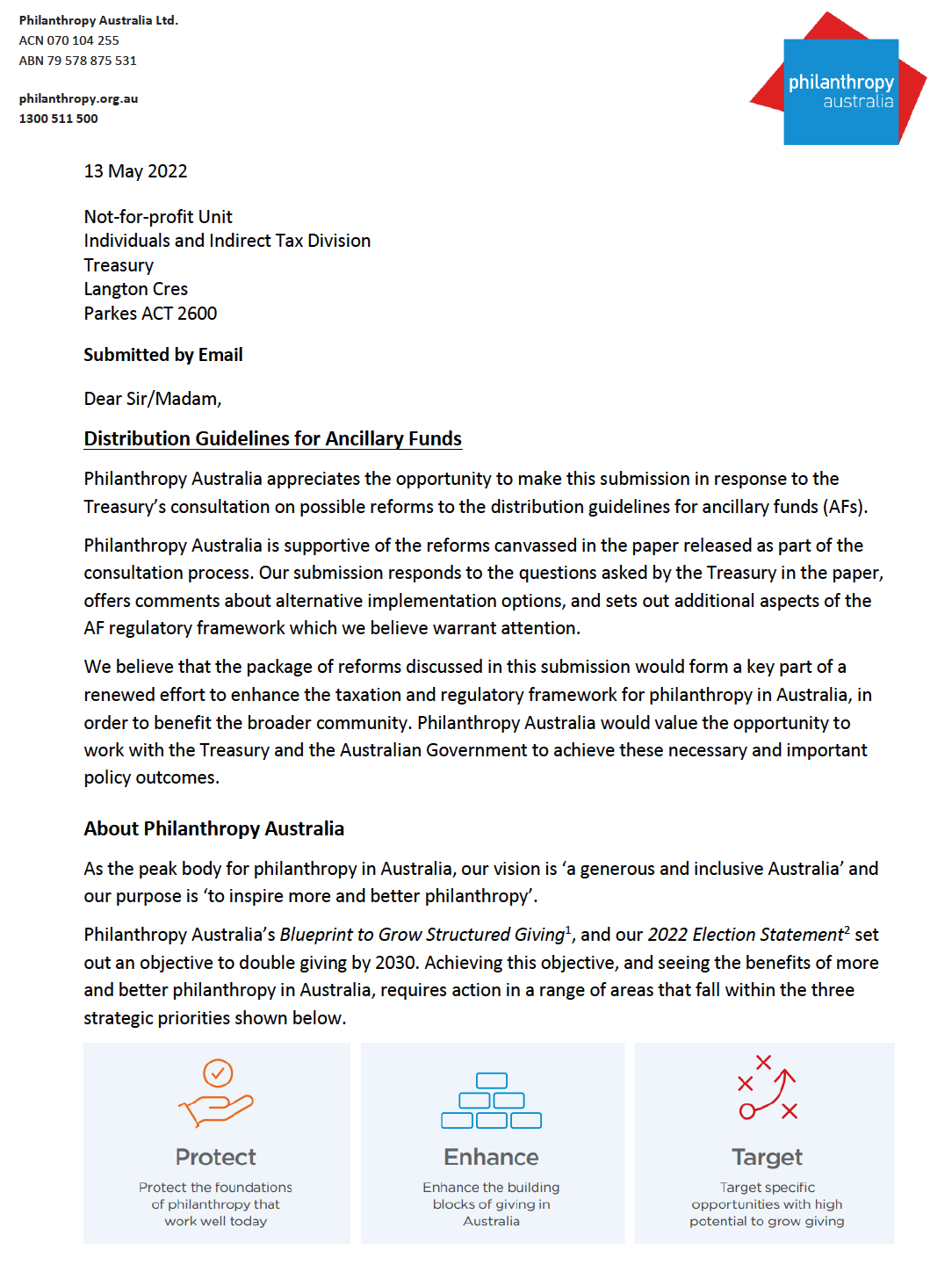Distribution Guidelines for Ancillary Funds submission 2022
Our submission to Treasury in response to a consultation on reforms to distribution guidelines for ancillary funds.
Philanthropy Australia lodged a submission to Treasury in response to a consultation on reforms to distribution guidelines for ancillary funds.
Our submission responded to the matters raised in the consultation paper, and put forward a number of proposals aiming to enhance the effectiveness and flexibility of the regulatory framework for ancillary funds.
Australian Government consultation on ancillary fund distributions
The Australian Government released a consultation paper seeking feedback on options to improve the flexibility of ancillary funds. It canvassed 2 possible reforms:
- Allowing ancillary funds to access a lower minimum distribution rate for a certain period of time, where they are seeking to accumulate funds to make a large grant and with the approval of the Australian Taxation Office
- Allowing ancillary funds to make grants to other ancillary funds, subject to certain limitations in order to preserve the philanthropic nature of ancillary funds
Philanthropy Australia advocates for enhanced flexibility in relation to ancillary funds making grants to other ancillary funds. The current restrictions are a barrier to collaborative funding approaches and to enabling private ancillary funds – in particular to benefit from the grantmaking expertise of community foundations and other organisations that use a public ancillary fund structure. We therefore welcomed the release of the consultation paper.
Philanthropy Australia prepared a draft submission and shared it with our members to seek their input and feedback.
For more information see Distribution guidelines for ancillary funds on the Treasury website.
Guidance on changes to electoral laws
Amendments to the Commonwealth Electoral Act 1918 – passed late 2021 – changed some of the disclosure and reporting requirements in relation to charities and other organisations that undertake or fund advocacy in relation to Federal elections.
These changes do not impact the Australian Charities and Not-for-profits Commission (ACNC) regulatory framework, nor do they alter the law relating to advocacy as a charitable purpose under the Charities Act 2013 (Cth) – this remains the same.
The guidance, consisting of a presentation by Arnold Bloch Liebler (ABL) and a table relating to donor disclosure and reporting requirements under the Commonwealth Electoral Act 1918 shares that there may be implications in terms of disclosure and reporting requirements relating to grants made for the purposes of advocacy, where this occurs in relation to Federal elections. The Australian Environmental Grantmakers Network (AEGN) worked with ABL to provide guidance about the changes and their impact, and Philanthropy Australia thanks Amanda Martin and the AEGN for enabling us to share this with Philanthropy Australia’s members.
Most Philanthropy Australia members are not expected to be impacted by the changes – it is important to note that the changes do not relate to all advocacy by charities, and they do not impose any new restrictions or limits on funding advocacy. However, the guidance will assist those members that fund advocacy and would like to better understand the changes.
For more information, see:
- ABL Electoral Act presentation on the ABL website
New Public Ancillary Fund Guidelines in effect (February 2022)
New Public Ancillary Fund Guidelines came into effect on 25 February 2022, replacing the previous Guidelines dating from 2011 that were due to sunset in April this year. The new Guidelines do not introduce any new regulatory requirements for public ancillary funds, but focus mainly on updating the drafting and language used. Importantly, concerning changes proposed in the draft Guidelines that were subject to consultation late last year were not proceeded with.
These sought to impose additional eligibility requirements for Responsible Persons, and would have had wide ranging and harmful impacts. Philanthropy Australia took a strong stance opposing these changes, both in our submission to Treasury and direct representations made to the Assistant Treasurer’s office. We are pleased that our advocacy efforts were successful, and appreciate the responsive of the Assistant Treasurer and Treasury to our concerns.
